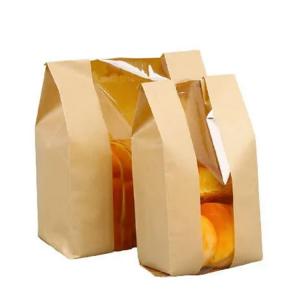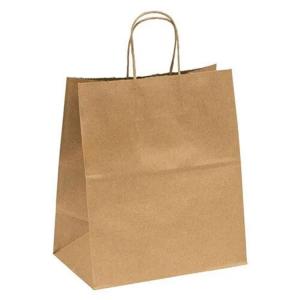- English
- Español
- Português
- русский
- Français
- 日本語
- Deutsch
- tiếng Việt
- Italiano
- Nederlands
- ภาษาไทย
- Polski
- 한국어
- Svenska
- magyar
- Malay
- বাংলা ভাষার
- Dansk
- Suomi
- हिन्दी
- Pilipino
- Türkçe
- Gaeilge
- العربية
- Indonesia
- Norsk
- تمل
- český
- ελληνικά
- український
- Javanese
- فارسی
- தமிழ்
- తెలుగు
- नेपाली
- Burmese
- български
- ລາວ
- Latine
- Қазақша
- Euskal
- Azərbaycan
- Slovenský jazyk
- Македонски
- Lietuvos
- Eesti Keel
- Română
- Slovenski
Why are kraft paper bags becoming more and more popular?
2025-09-16
According to the 2023 report of the Global Packaging Industry Association, the annual production of kraft paper bags reached 430 billion units, with a five-year growth rate of 17.2%, far exceeding the 3.1% growth rate of plastic packaging. This container, made from pure wood pulp or recycled fibers, is reshaping the packaging industry at a scale of replacing 3.8 million tons of plastic usage annually.

Environmental benefits:
In terms of the degradation cycle, the 28-day decomposition rate of kraft paper bags can reach 92%, which is much lower than the 400-year lifespan of ordinary plastic bags. The carbon emission comparison is even more significant. A single kraft paper bag generates only 50 grams of carbon dioxide equivalent throughout its life cycle, less than half of the 120 grams emitted by plastic shopping bags. This advantage is translating into actual environmental benefits: after the 7-Eleven chain stores in Japan adopted composite paper bags containing 30% rice straw fibers, the annual plastic consumption per store decreased by 1.2 tons; the paper bag recycling system established by IKEA's global stores achieved an average reuse of 8.3 times per bag, reducing disposable packaging consumption by 86 million pieces in 2023.
Material technology updates:
The material technology of kraft paper bags is constantly being updated. The Finnish paper giant Stora Enso developed a nanocellulose coating technology, which enhances the fiber bonding force, increasing the tensile strength of the paper bag by 150% and breaking the load limit to 15 kilograms. Regarding leakage, the American EcoCortec company developed a plant-based waterproofing agent that gives kraft paper bags the ability to remain dry for 72 hours in a 90% humidity environment. The most remarkable breakthrough comes from the cold chain field. Chinese fresh produce enterprises adopted phase change material sandwich paper bags, maintaining a damage rate of 0.7% within a temperature range of -25°C to 40°C, successfully solving the transportation problem of frozen goods.

Policy-driven:
The environmental legislation of various countries has formed a strong institutional driving force. After the EU implemented a 0.8-euro per kilogram plastic packaging tax, the proportion of kraft paper bags in retail packaging rose from 19% to 77% within three years. The "14th Five-Year Plan" of China clearly requires that e-commerce platforms ban non-degradable packaging by 2025, directly stimulating an additional 400,000 tons of food-grade paper bag production capacity in China. After California implemented a plastic bag ban, local paper bag consumption increased by 210% within two years, and the chain reaction led to a 45% increase in North American paper machinery investment. These policies have led to an increasing use of kraft paper bags.
Consumer perception:
A global survey by Nielsen in 2024 revealed that 68% of consumers are willing to pay a 5-10% premium for environmentally friendly packaging, with the acceptance rate of premium pricing among the 25-35 age group reaching 83%. In terms of packaging experience, the "natural touch" of kraft paper bags received a preference index of 87 points, far exceeding the 35-point rating of plastic packaging. Market feedback validates this trend: after Starbucks switched to coffee bags containing 40% recycled fibers, the rate of active social media users posting reviews increased by 27%; the brand recognition of Uniqlo's FSC-certified paper bags reached 91%, 12 percentage points higher than its trademark recognition rate.
| Factor | Key Data |
|---|---|
| Global Production | 430 billion bags/year · 17.2% growth (5-year) |
| Plastic Replacement | 3.8 million tons/year |
| Degradation | 28 days (92% decomposition) vs plastic 400 yrs |
| Carbon Footprint | 50g CO₂e/bag (vs plastic 120g) |
| Material Strength | 150% stronger · 15kg load capacity |
| Moisture Resistance | 72 hours (90% humidity) |
| Cold Chain Performance | 0.7% damage rate (-25°C to 40°C) |
| Policy Impact | |
| ‧ EU Plastic Tax | 77% paper adoption in 3 years |
| ‧ China 2025 Ban | +400, 000-ton capacity |
| ‧ California Ban | 210% consumption increase |
| Consumer Preference | |
| ‧ Price Premium | 68% accept +5-10% cost |
| ‧ Youth (25-35) | 83% premium acceptance |
| ‧ Brand Impact | Starbucks: +27% social engagement |
| ‧ Recognition | Uniqlo: 91% FSC bag awareness |
| Reuse Efficiency | IKEA: 8.3 reuses/bag |




